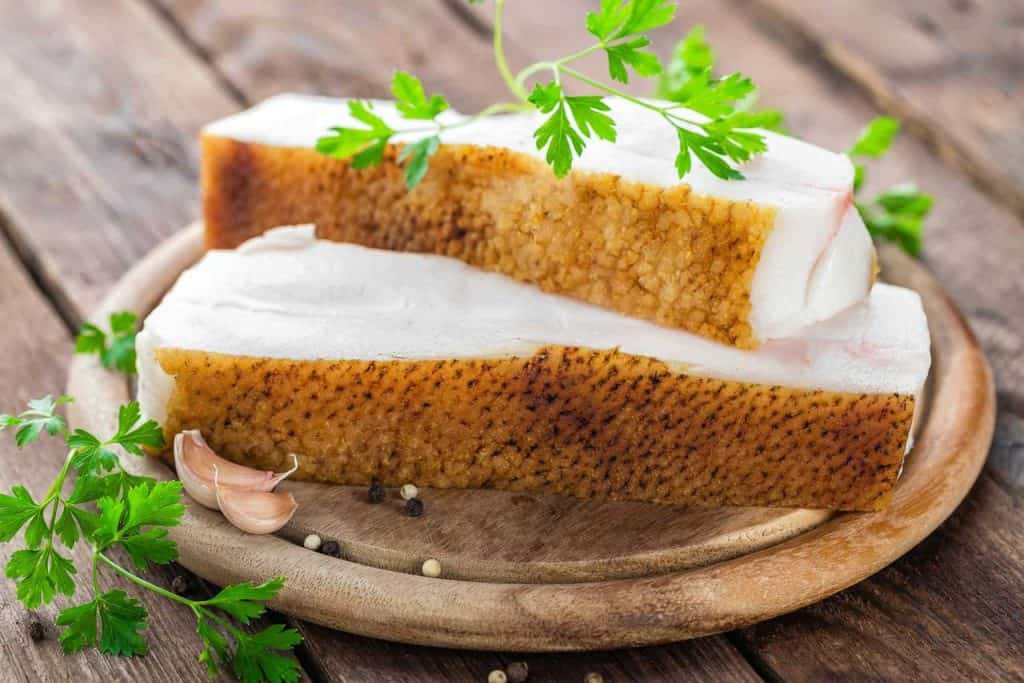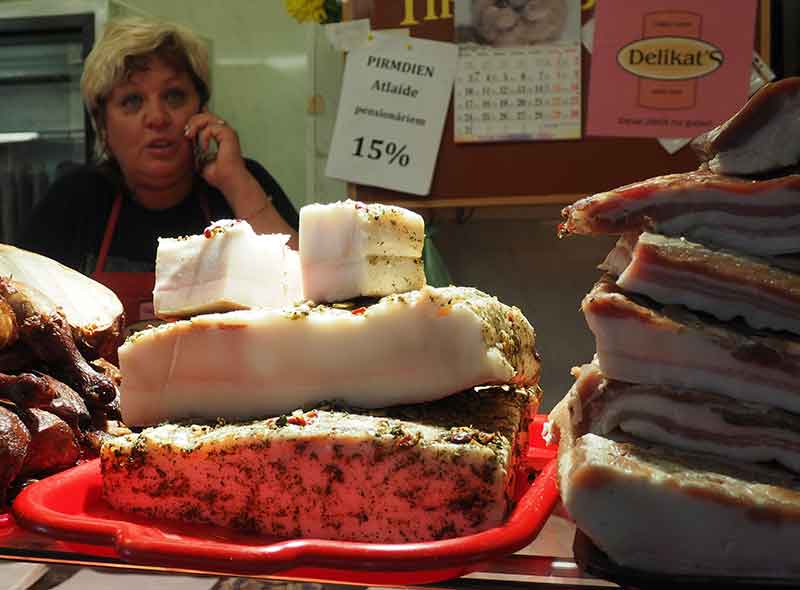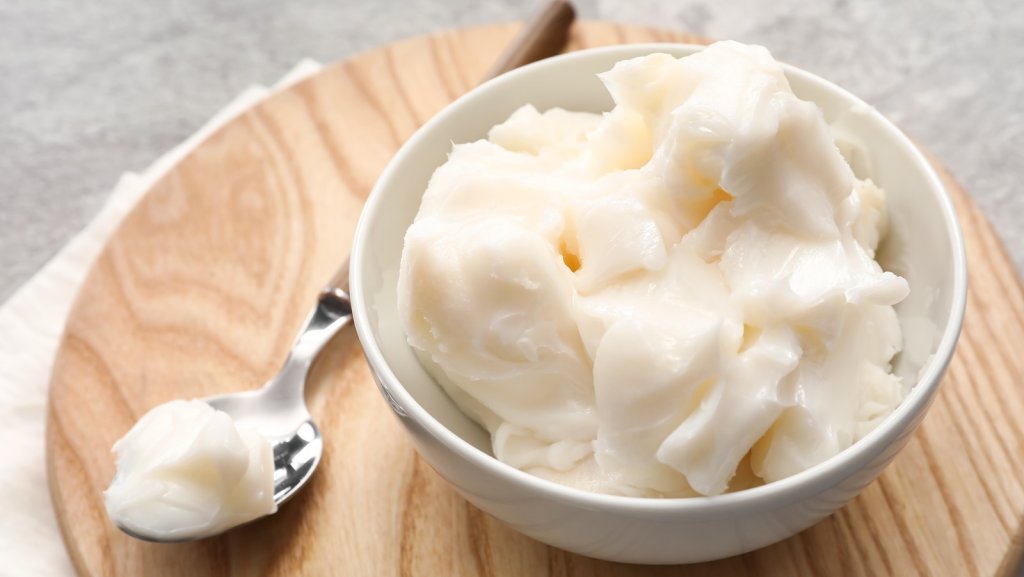Exploring the world of cooking fats, the Lard vs Suet debate compares two traditional fats used in various cuisines.
This article delves into the nuanced differences between lard, the rendered fat from pigs, and suet, the raw, hard fat around cows’ or sheep’s kidneys and loins.
While both fats have unique characteristics and culinary uses, they differ significantly in source, texture, flavor, and usage in cooking.
Understanding these differences is essential for cooks and culinary enthusiasts who wish to make informed choices about the fats they use for baking, frying, or creating specialty dishes.
Lard vs Suet: Everything to Know About

Lard is the rendered fat from a pig. It is the most common fat product we hear of and is more famous than tallow and suet.
Lard generally comes from the belly of a pig. It is shelf-stable enough to be used in cooking later as it is rendered and cleared after extracting from the body.
Pigs contain a thick layer of fat under their body, providing a quantity of fat.
Pigs brought up by free raging provide a quality fat rich in nutrients and minerals.
In contrast, those brought up on farms by feeding on grains and other vegetarian products do not have that good quality but a thicker layer of fat.
Lard is the fat commonly found in the pigs’ belly areas and around some internal organs.
Tallow is obtained from the kidney part of the cows and the area around the kidney.
It is a complex, fatty substance usually found in ruminants or other words, and we can say animals with two or more stomachs.
Sheep and deer are the other examples from which tallow could be obtained.
Tallow is shelf-stable enough for later use in cooking or developing other things like soaps and candles. Tallow is originated by suet only by rendering it.
On the other hand, Suet is the fat that is white and hard, and it is mainly found in kidneys and nearby areas in cows and other ruminants.
Suet is not found soft and malleable at room temperature but is more brutal and tends to be crumbly.
High temperature is required for suet and baking, and cooking can only be done at high temperature.
You will not be found suitable for later use as it is not as shelf-stable as tallow and lard and needs to be stored in the freezer. Bird feeding is also done by suet.
Nonkitchen items made with suet fat are much better than kitchen products because of their non-shelf-stable nature.
Its taste is very mild and is typically shredded and chopped, making it suitable for adding taste and richness to food.
A Quick Overview: Lard vs Suet
Lard
- It’s the most popular fat than any other.
- A type of solid fat.
- It is found in the body of pigs and their internal organs.
- Not only in pigs but could be found in ducks and other animals also.
- Made shelf-stable by clarifying and rendering.
- Could be found malleable and soft} at room temperature
- Leaf lard is one of the best lards you could find.
- It could be used in cooking, also.
Suet
- It is a complex, white fat around the kidneys and belly of cows and other animals.
- Suet gives rise to fat after rendering.
- Need high temperature for cooking and baking.
- Not as shelf-stable as tallow or lard
- Used in suet bird feeders.
Another significant variety is made up from the addition of tallow, how does it differentiate from the basic overview of lard vs suet, here’s a brief description on it.
Tallow
- It is obtained from cows or other ruminants like sheep and deer.
- It is usually made from the fat of the kidneys and the parts around it.
- It is highly Shelf-stable, like lard.
- It could be used significantly in cooking, soap and candles, and skincare products.
- Tallow is soft and malleable like lard, and besides, is a solid fat at room temperature.
Marking Difference: Lard vs Suet

For better clarity on noting the lard vs suet difference, we have marked a few parameters that precisely list the point diversification between the two. Here’s a glance at it.
Source
- Lard: Rendered fat from pigs.
- Suet: Raw, hard fat from around the kidneys and loins of cows or sheep.
Texture
- Lard: Soft and spreadable at room temperature.
- Suet: Firm and crumbly, becoming softer when heated.
Flavor
- Lard: Mild, pork-like flavor.
- Suet: More robust, meaty flavor, especially when from beef.
Usage in Cooking
- Lard: Commonly used in baking for flaky pie crusts, pastries, and frying.
- Suet: Often used in traditional British puddings, mincemeat, and savory dishes like dumplings.
Health Aspects
- Lard: Higher in monounsaturated fats.
- Suet: Higher in saturated fats.
Smoking Point
- Lard: Medium-high smoking point, suitable for frying.
- Suet: High smoking point, excellent for deep-frying and roasting.
Storage
- Lard: Can be stored in the refrigerator or at room temperature.
- Suet: Best stored in the refrigerator or freezer to maintain its hard texture.
Vegetarian/Vegan Alternatives
- Lard: No direct vegetarian substitutes due to its animal origin.
- Suet: Vegetable suet is available as an alternative for vegetarians.
Culinary Traditions
- Lard: Used globally, especially in American, Mexican, and Chinese cuisines.
- Suet: More common in British and Irish cooking, particularly in traditional recipes.
Lard vs Suet: A Detailed View on Usage
Suet
- Minced meat dishes and cakes
- Traditional British food such as steamed pudding and cakes.
- Bird food
- The best-known culinary use for tallow is traditional British savory dishes such as mince pies and mince dishes. It is also used in traditional British foods such as steamed puddings and cakes.
Lard
- Lard can be used in cooking and baking as well. You could make cake crusts, cookies, and shortbread cakes. It can also be used to fry eggs and other foods.
- It could also be used for making grease containers.
- Season cast-iron cookware and soaps also use lard in their production.
- Some candles also use lard fat.
- It protects and conditions leather and wood and is best combined with beeswax.
- For their moisturizing properties, the skincare, balms, and soap contain lard in them.
- There are many uses in the kitchen and around the house of lard. The best-known traditional uses for lard are in cooking and baking. It is used in cooking as a healthier alternative to hydrogenated oils like vegetable oils.
Lard’s main uses in the kitchen have traditionally been preparing dough for cakes, sponge cakes, and other pastries because it makes them flakier. It can also be used to fry foods such as eggs and preserve foods such as chickens, ducks, and other meats.
Lard is usually used in the kitchen to grease pans as cake plates. You can also use it to season cast iron cookware.
Usage of Tallow
Tallow can also be used to make bird food besides the kitchen.
To make a tallow bird feeder, it can be used alone or mixed with other bird feeders.
Peanut butter can also be mixed with an equal amount of birdseed. Such food can be prepared, and containers filled with them can be kept in trees for the birds.
During winter, bird food made up of suet is an excellent food source that birds can have where other food sources are scarce, as it is a food source with high energy.
- Tallow is used in making soap and candles as well.
- Cooking is another major field where tallow is popular.
- Tallow is ideal for frying in high-temperature cooking.
- Skincare is done beautifully by tallow products.
- Balms and moisturizers use tallow in them.
- Grease squeaky items are also made up of tallow.
- It protects and conditions leather and wood and can be best combined with beeswax. Tallow has been plentiful and cheap, making it the best-known fat for making soap and candles and cooking and frying.
As tallow has a 400 degrees Fahrenheit high smoke point, it is a good fat for cooking in high heat and deep chicken frying. Skincare can be done better by it as it is a good moisturizer.
It could be used as a base in body balms and is best for nourishing and repairing chapped skin in body parts like hands, feet, and lips.

